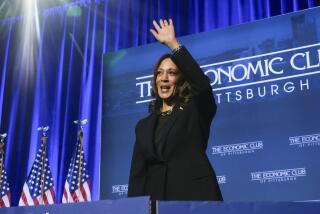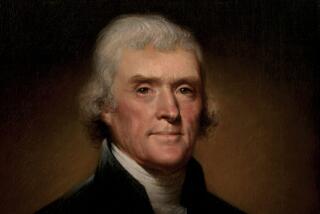Bush Pushes Growth Plan Amid Skepticism
WASHINGTON â WASHINGTON -- President Bush opened a concerted administration drive to promote his $674-billion economic recovery plan Thursday, seeking to overcome mounting skepticism toward his prescription for stimulating a sluggish economy.
Addressing workers and their families at a flag-making plant outside Washington, Bush fumed that Democrats are practicing âclass warfareâ by calling his plan skewed in favor of the wealthy. He adamantly rejected their allegation, saying at one point: âThis town is an ugly town that way.
âThis is a fair plan. It is an important plan. And itâs a plan that will help people find work -- because it will help keep this economy growing,â Bush said.
He vowed a vigorous campaign to marshal public backing and win congressional support. âI wonât yield,â he said.
The presidentâs remarks came amid fresh signs on Capitol Hill that he faces a difficult selling job. Earlier in the day, Lincoln Chafee of Rhode Island became the first Republican senator to publicly oppose Bushâs plan.
âThereâs a tremendous education challenge,â acknowledged Johanna Schneider, spokeswoman for the Business Roundtable, which backs the elimination of dividend taxes, a central element of the plan.
Indeed, Bushâs plan may suffer, at least initially, because many Republicans in Congress were taken by surprise by its magnitude and details. That left some bruised egos among the lawmakers, some Republicans say.
In a signal of the importance the White House attaches to Bushâs stimulus plan, Vice President Dick Cheney is scheduled today to talk up the proposal before the U.S. Chamber of Commerce in Washington.
Cheney rarely makes such high-profile appearances. And Bush himself plans to continue to tout his plan across the country.
âYou can anticipate, as the new year begins, the president aggressively pursuing his domestic agenda for the country,â said White House Press Secretary Ari Fleischer. âThat will include a number of new initiatives; it will include a number of visits throughout the country to different places.â
But at his first stop Thursday, Bush encountered some unexpected criticism of the plan. Before speaking at the National Capital Flag Co. in Alexandria, Va., he participated in a round-table discussion with the firmâs owner and seven other participants.
During the 30-minute discussion, Don Lucas, a retired accountant, politely told Bush that he viewed his proposal to eliminate taxes on dividends as unfair.
âItâs a good idea, but Iâve got to be honest with you, I donât think itâs fair,â Lucas, 74, told the president. âI think corporations should pay taxes on their profits and I should pay taxes on the dividends that come to me as income.â
âThatâs the debate,â Bush replied.
Lucas, a Democrat, later told reporters that he agreed with the presidentâs objective of jump-starting the economy, but questioned whether eliminating dividend taxes would achieve the result.
According to a White House information sheet, Lucasâ annual income of $65,000 includes about $5,000 in taxable dividends. Under Bushâs plan, Lucas would see his tax bill cut by about $1,800, with all but $500 of that a direct result of the abolition of the dividend tax.
Hector V. Barreto, head of the Small Business Administration, said that Lucas âcame aroundâ as the president more fully explained his rationale after the session.
âThe more people get to understand the plan, and what the implications are, the more people will support it,â Barreto said.
Bush used his speech at the 35-employee flag company to highlight one element of his stimulus package: raising to $75,000 from $25,000 the amount that a business may deduct for investing in equipment.
Flag company owner Al Ulmer Jr., whose product flies on the presidential limousine, said the higher limit would enable him to purchase two new pieces of equipment and hire two more workers.
âImagine all the different Als around the country that are making the same decision,â Bush said.
On Capitol Hill, Chafee, a moderate who also opposed the Bush-sponsored $1.35-trillion tax cut that passed in 2001, introduced legislation to block further reductions in upper-bracket income tax rates scheduled in 2004 and 2006. In his new plan, Bush wants to make those cuts and those scheduled for other brackets effective this year.
Joining Chafee in sponsoring the freeze on the cuts was another centrist, Sen. Dianne Feinstein (D-Calif.), who voted for the 2001 tax cut.
She called Bushâs new proposal âthe wrong plan at the wrong time. It digs the nation deeper into debt. It is not a stimulus. It is skewed to the wealthy. And it severely limits the governmentâs ability to pay for needed programs, like education, transportation and law enforcement.â
Separately, a bipartisan group of senators introduced legislation to provide $20 billion in aid to the states, to help them pay for Medicaid and social services. The group fears that Bushâs plan would worsen the fiscal situation in their states because many have revenue codes linked to federal tax laws.
More to Read
Get the L.A. Times Politics newsletter
Deeply reported insights into legislation, politics and policy from Sacramento, Washington and beyond. In your inbox three times per week.
You may occasionally receive promotional content from the Los Angeles Times.










